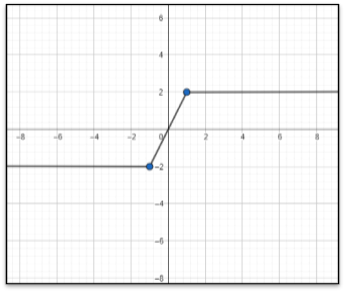Find the points of discontinuity, if any, of the following functions :

Basic Idea:
A real function f is said to be continuous at x = c, where c is any point in the domain of f if :
![]() where h is a very small ‘+ve’ no.
where h is a very small ‘+ve’ no.
i.e. left hand limit as x → c (LHL) = right hand limit as x → c (RHL) = value of function at x = c.
This is very precise, using our fundamental idea of limit from class 11 we can summarise it as, A function is continuous at x = c if :
![]()
Here we have,
 ……….equation 1
……….equation 1
Function is defined for all real numbers so we need to comment about its continuity for all numbers in its domain (domain = set of numbers for which f is defined)
For x < –1, f(x) is having a constant value, so the curve is going to be straight line parallel to x–axis.
So, it is everywhere continuous for x < –1.
It can be verified using limits as discussed in previous problems
Similarly for –1 < x < 1, plot on X–Y plane is a straight line passing through origin.
So, it is everywhere continuous for –1 < x < 1.
And similarly for x > 1, plot is going to be again a straight line parallel to x–axis
∴ it is also everywhere continuous for x > 1

From graph it is clear that function is continuous everywhere but let’s verify it with limits also.
As x = –1 is a point at which function is changing its nature so we need to check the continuity here.
f(–1) = –2 [using eqn 1]
LHL = ![]()
RHL = ![]()
Thus LHL = RHL = f(–1)
∴ f(x) is continuous at x = –1
Also at x = 1 function is changing its nature so we need to check the continuity here too.
f(1) = 2 [using eqn 1]
LHL = ![]()
RHL = ![]()
Thus LHL = RHL = f(1)
∴ f(x) is continuous at x = 1
Thus, f(x) is continuous everywhere and there is no point of discontinuity.